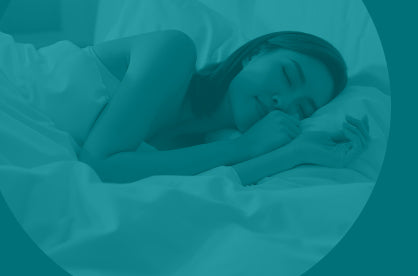
Did you know that in the animal kingdom, humans are the only ones who will purposely deprive themselves of sleep?
You’ve probably heard quips such as:
“Sleep is for quitters.”
“I’ll sleep when I’m dead.”
“Sleep is for lazy people.”
But the secret is out… people who say these things are very very wrong (and will likely die sooner than those who get more sleep!).
In this article, we will discuss exactly what sleep is (including sleep stages), the neurotransmitter involved in sleep, and a bit of sleep physiology using the latest available research evidence.
What Exactly is Sleep?
Sleep is more than just the absence of wakefulness. Rather, it is an active, regulated, and distinct state that is fundamental for daytime functioning and overall health [1].
It is a state marked by drastic physiological changes, the most evident of which occur in the brain and central nervous system. During sleep we are in a state of altered consciousness and reduced muscle activity that is characterized by diminished ability to react to our surrounding environment. Sleep is distinguished from a coma or state of disordered consciousness, however, as the brain is still in an "active" state.
Sleep seems to be a feature of any organism with a neuronal/glial network, even including roundworms, fruit flies, and cuttlefish. Therefore, it can be said that sleep serves a function at even the very small network level (roundworms, for example, only have 302 neurons compared to our 86 billion!). It is a shared behavior that is conserved between a variety of organisms, including humans (obviously) [2].
When we sleep, we progress through several distinct phases. These comprise three stages of non-rapid eye movement (NREM) sleep and one stage of rapid eye movement (REM) sleep. It takes between 90 to 120 minutes to complete the full cycle [3,4], and the body does this around 4-6 times every night [5]. All of the sleep stages are marked by differences in muscle tone, brain wave patterns, and eye movements [5].
One of the essential functions of sleep is to promote an anabolic state, or an environment whereby systems are repaired and rebuilt. This process helps to revitalize the immune, nervous, skeletal, and muscular systems. The glymphatic system of the brain is essential to these processes.
It is recommended that adults should strive for 7 or more hours of sleep per night on a regular basis for optimal health [6]. Sleeping less than this amount for a prolonged duration is linked with adverse health outcomes such as weight gain and obesity, diabetes, hypertension, heart disease and stroke, depression, and increased risk of death [6]. It is also associated with impaired immune function, increased pain, impaired performance, an increased amount of errors in cognitive tasks, and a greater risk of accidents [6]. Newer science is trying to determine whether it is the time in bed that’s important or how much of each stage of sleep you are getting... and no surprise, it’s likely the latter.
What Happens During Deep Sleep?
The third stage of NREM sleep is called deep sleep, or "slow wave sleep." This is because our brain waves are at their slowest during this phase (they are often referred to as delta waves) with a frequency of 0.5-2 Hz [1,7].
While all sleep phases are important for health, deep sleep is distinguished by its physical and mental benefits. It is essential for maintaining the learning efficiency of the brain – in other words, it restores the ability of the brain to learn in an efficient way, especially in regions that undergo heavy activation during the day [8]. The longer we are awake, the more the neuroplasticity of the brain is reduced, which is then restored during uninterrupted deep sleep.
The brain receives a tremendous amount of information throughout the day, which strengthens the synaptic networks (awesome work, brain!), however it can only do this for so long without rest. During deep sleep, the brain consolidates this information and prepares the synapses for the next day [9].
Interruption of or abnormalities in NREM sleep are associated with a number of cognitive disorders, such as Alzheimer’s disease and dementia [10], epilepsy [11], and autism spectrum disorders, to name a few [12].
What About REM Sleep?
REM sleep is the mode that is associated with active dreaming, during which brain activity resembles wakefulness. It is characterized by jerky, erratic eye movements in all directions, hence the name. The switch between REM and NREM sleep seems to be controlled by monoaminergic neurons and a specific subset of cholinergic neurons in the brain stem [1].
REM sleep is physiologically distinct from the other phases of sleep because, for the most part, the brain is wide awake. It has been proposed that this sleep stage is used by the brain to wake itself up after it has had enough sleep [16]. In this stage, acetylcholine levels are at their highest. Sudden interruption of REM sleep, or "sleep inertia" [17], can leave us feeling groggy and fatigued, due to the high levels of melatonin that are still present.
What Neurotransmitters are Involved in Sleep?
Multiple brain regions interact to modulate sleep and wakefulness, with wakefulness governed by wake-promoting neurons (WPNs), and sleep governed by sleep-promoting neurons (SPNs).
WPNs comprise noradrenergic neurons of the locus coeruleus, serotonergic neurons of the raphe nuclei, and histaminergic neurons of the tuberomammillary nucleus. SPNs, on the other hand, include melanin-concentrating hormone-producing neurons in the diencephalon and GABAergic neurons in the ventrolateral and median preoptic nuclei as well as the brain stem parafacial zone [13].
The hypothalamus is the area of the brain that is most important in the regulation of sleep duration.
Specific groups of hypothalamic neurons and others in the basal forebrain produce GABA (gamma-aminobutyric acid), an important inhibitory neurotransmitter. Projections of these GABA neurons inhibit the firing of cells involved in keeping us awake [14].
The action of these GABA neurons inhibits neurons containing glutamate, histamine, norepinephrine, serotonin, and hypocretin, which ultimately promotes sleep [14].
Separately, increased levels of the neuromodulator adenosine enhance the need for sleep, the so-called "sleep drive." Adenosine accumulates throughout the day and is then removed when we sleep. It is normally found as part of a molecule called adenosine triphosphate or ATP, which is our body’s energy currently, made in the mitochondria.
Caffeine acts by blocking adenosine receptors and therefore offsets the effects of sleep deprivation on arousal, vigilance, and attention [15]. This is great when we’re trying to stay alert at work but becomes a drawback when we’re trying to get to sleep. Of note, caffeine has a long half-life as well, so be aware of your caffeine metabolism status (i.e., slow, normal, or fast)!
Conclusion
Sleep is kind of a big deal. It’s not for quitters. It’s not for lazy people. And if you don’t sleep, you die faster. So, in short, prioritizing sleep is essential to optimizing your healthspan and your lifespan. The good news is that there are many ways to do this now, from establishing a good sleep routine (no screens and getting yourself some blue blockers) to making a fantastic sleep environment (i.e., make your room cold and dark!) to supplements including those that can help you relax and stop perseverating (i.e., stop you from having ruminating thoughts).
Here at Troscriptions, we got you covered with Tro Calm which will help you relax and stop those ruminating thoughts via ingredients like kava and N-nicotinoyl-GABA which both modulate the GABA system. Getting to bed faster and sleeping more deeply sounds pretty awesome right about now, right?
“Your day starts when you go to sleep, not when you wake up.”
—Dr. Ted Achacoso, founder of Troscriptions and Pioneer of Health Optimization Medicine and Practice (HOMe/HOPe)
References
[1] D.W. Carley, S.S. Farabi, Physiology of Sleep, Diabetes Spectr. 29 (2016) 5–9. https://doi.org/10.2337/diaspect.29.1.5.
[2] J.M. Krueger, M.G. Frank, J.P. Wisor, S. Roy, Sleep function: Toward elucidating an enigma, Sleep Med Rev. 28 (2016) 46–54. https://doi.org/10.1016/j.smrv.2015.08.005.
[3] K.N. Anderson, A.J. Bradley, Sleep disturbance in mental health problems and neurodegenerative disease, Nat Sci Sleep. 5 (2013) 61–75. https://doi.org/10.2147/NSS.S34842.
[4] A. Moszczynski, B.J. Murray, Neurobiological aspects of sleep physiology, Neurol Clin. 30 (2012) 963–985. https://doi.org/10.1016/j.ncl.2012.08.001.
[5] A.K. Patel, V. Reddy, J.F. Araujo, Physiology, Sleep Stages, in: StatPearls, StatPearls Publishing, Treasure Island (FL), 2022. http://www.ncbi.nlm.nih.gov/books/NBK526132/ (accessed August 27, 2022).
[6] N.F. Watson, M.S. Badr, G. Belenky, D.L. Bliwise, O.M. Buxton, D. Buysse, D.F. Dinges, J. Gangwisch, M.A. Grandner, C. Kushida, R.K. Malhotra, J.L. Martin, S.R. Patel, S.F. Quan, E. Tasali, Recommended Amount of Sleep for a Healthy Adult: A Joint Consensus Statement of the American Academy of Sleep Medicine and Sleep Research Society, Sleep. 38 (2015) 843–844. https://doi.org/10.5665/sleep.4716.
[7] J.M. Saletin, Memory: Necessary for Deep Sleep?, Curr Biol. 30 (2020) R234–R236. https://doi.org/10.1016/j.cub.2020.01.038.
[8] S. Fattinger, T.T. de Beukelaar, K.L. Ruddy, C. Volk, N.C. Heyse, J.A. Herbst, R.H.R. Hahnloser, N. Wenderoth, R. Huber, Deep sleep maintains learning efficiency of the human brain, Nat Commun. 8 (2017) 15405. https://doi.org/10.1038/ncomms15405.
[9] C. Cirelli, G. Tononi, The Sleeping Brain, Cerebrum. 2017 (2017) cer-07-17.
[10] B.P. Lucey, A. McCullough, E.C. Landsness, C.D. Toedebusch, J.S. McLeland, A.M. Zaza, A.M. Fagan, L. McCue, C. Xiong, J.C. Morris, T.L.S. Benzinger, D.M. Holtzman, Reduced non-rapid eye movement sleep is associated with tau pathology in early Alzheimer’s disease, Sci Transl Med. 11 (2019) eaau6550. https://doi.org/10.1126/scitranslmed.aau6550.
[11] B. Schmitt, Sleep and epilepsy syndromes, Neuropediatrics. 46 (2015) 171–180. https://doi.org/10.1055/s-0035-1551574.
[12] A.-C. Rochette, I. Soulières, C. Berthiaume, R. Godbout, NREM sleep EEG activity and procedural memory: A comparison between young neurotypical and autistic adults without sleep complaints, Autism Res. 11 (2018) 613–623. https://doi.org/10.1002/aur.1933.
[13] J. Oh, C. Petersen, C.M. Walsh, J.C. Bittencourt, T.C. Neylan, L.T. Grinberg, The role of co-neurotransmitters in sleep and wake regulation, Mol Psychiatry. 24 (2019) 1284–1295. https://doi.org/10.1038/s41380-018-0291-2.
[14] J.M. Siegel, The neurotransmitters of sleep, J Clin Psychiatry. 65 Suppl 16 (2004) 4–7.
[15] E. Urry, H.-P. Landolt, Adenosine, caffeine, and performance: from cognitive neuroscience of sleep to sleep pharmacogenetics, Curr Top Behav Neurosci. 25 (2015) 331–366. https://doi.org/10.1007/7854_2014_274.
[16] W.R. Klemm, Why does rem sleep occur? A wake-up hypothesis, Front Syst Neurosci. 5 (2011) 73. https://doi.org/10.3389/fnsys.2011.00073.
[17] A.T. Wertz, J.M. Ronda, C.A. Czeisler, K.P. Wright, Effects of sleep inertia on cognition, JAMA. 295 (2006) 163–164. https://doi.org/10.1001/jama.295.2.163.






Comments (0)
There are no comments for this article. Be the first one to leave a message!